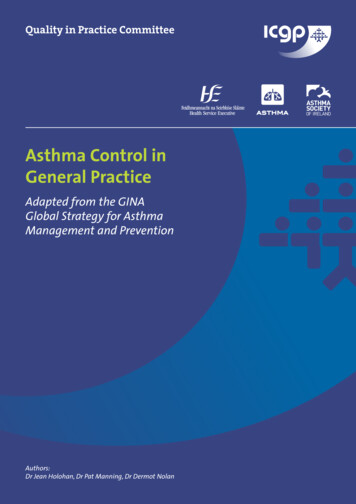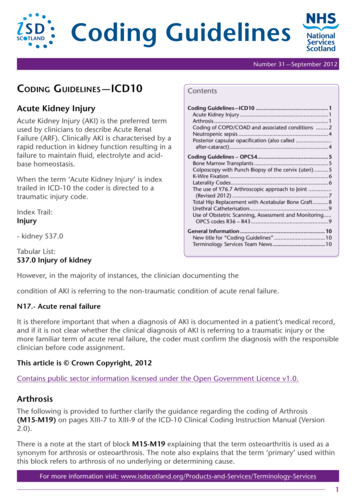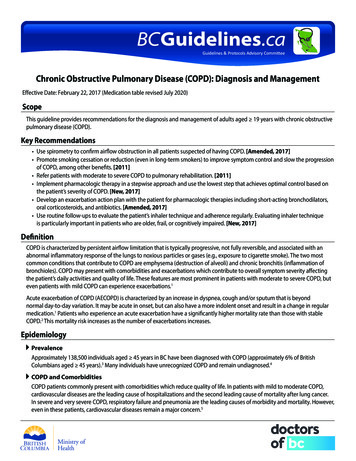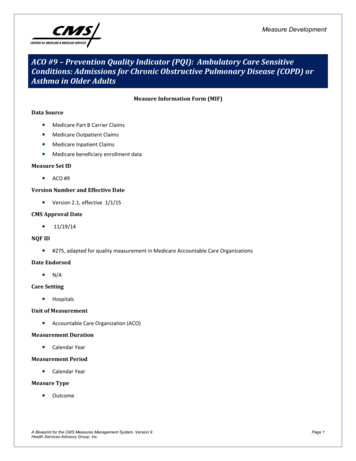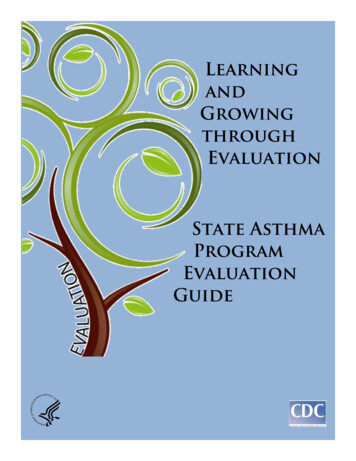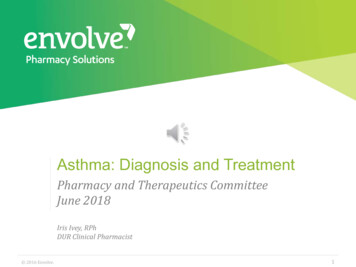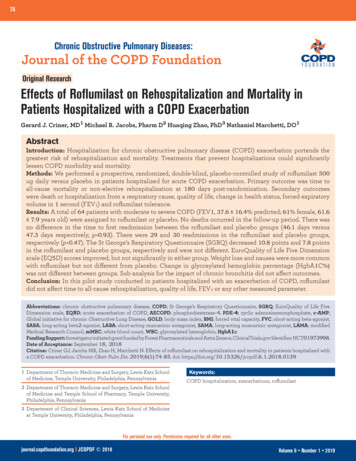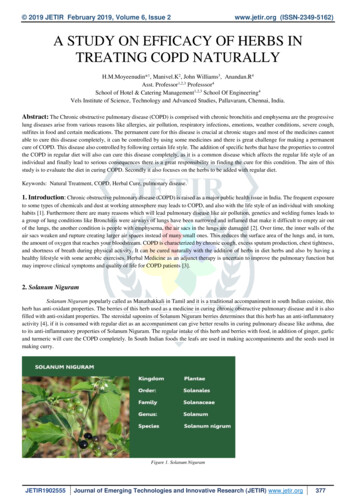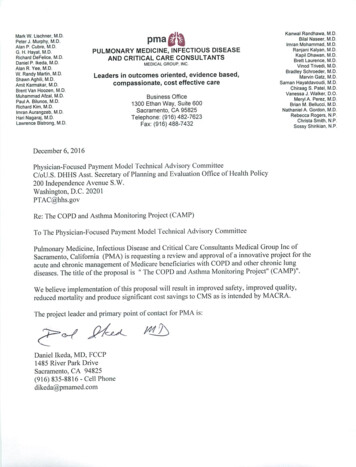
Transcription
The COPD and Asthma Monitoring Project(CAMP)i
Table of Contents:AbstractPage ivI. Background and Model OverviewPage 1II. Scope of Proposed PFPMPage 3III. Quality and CostPage 5IV. Payment MethodologyPage 14V. Value over VolumePage 17VI. FlexibilityPage 18VII. Ability to be EvaluatedPage 18VIII. Integration and Care CoordinationPage 18IX. Patient ChoicePage 19X. Patient SafetyPage 20XI. Health Information TechnologyPage 20Appendix A (Supplemental Information)Appendix A-1Operational Template for Implementation of CAMPPage 2Appendix A-IICirrusMD - Secure text messaging for virtual acute carePage 16Appendix A-IIIExample of a commercial Bluetooth enabled Peak Flow MeterPage 22Appendix A-IVAbout Pulmonary Medicine Associates (PMA)Page 28Appendix A-VHealthgrades Quality Awards to Hospitals where PMAdirects care in Pulmonary and Critical Care ServicesPage 29Appendix A-VIDaniel Ikeda, MD FCCP, Curriculum VitaePage 30Appendix A-VIILetters of EndorsementPage 33ii
2013State of California Department of Health and Human ServicesCalifornia Medical AssociationSierra Sacramento Medical SocietyRiver City Medical Group2016Sutter Independent Physicians Medical GroupMercy General Hospital, Sacramento, CAMercy San Juan Hospital, Carmichael, CASutter Medical Center, Sacramento, CASutter Roseville Hospital, Roseville, CA(Note: The 4 hospitals above are on present and/or past "'Top 100Hospitals" lists)Appendix B - Cited ArticlesAppendix B-IMedicare Payment: How Much Do Chronic ConditionsMaatter? Erdem, et alPage 2Appendix B-IIA Home Telehealth Program for Patients with SevereChronic Obstructive Pulmonary Disease in Taiwan A Randomized Control Trial. Hoe, et alPage 16Appendix B-IIIA Home telehealth program for patients withsevere COPD: The PROMETE study. Calvo, et alPage 21Appendix B-IVHealth-economic evaluation of home telemonitoring forCOPD in Germany: evidence from a large population-basedcohort. Achelrod, et alPage 34iii
AbstractThe COPD and Asthma Monitoring Project (CAMP) is a proposed payment modeldesigned to treat a population of high risk Medicare beneficiaries with COPD andother chronic lung conditions. Care of this high risk population is providedthrough remote interactive monitoring that brings all the resources to leverage theexpertise of a large telemedicine, pulmonary and allergy practice in the acute andchronic management of large populations of patients with COPD, asthma and otherchronic lung diseases. Novel data presentation formats, computerized decisionsupport, and smart alarms are used to enhance patient safety, patient education,patient compliance, increase effectiveness, and standardize clinical and operatingprocesses. In addition, the technology infrastructure facilitates performanceimprovement by providing an automated means to measure outcomes, trackperformance, and monitor resource utilization. The program is designed to supportan integrated healthcare delivery system as well as the independent practicingphysician. If approved, CAMP will improved quality, decreased mortality whileproducing large cost savings for CMS.iv
I. Background and Model OverviewThe COPD and Asthma Monitoring Project (CAMP) is a proposed care model to addressexpensive inefficiencies in the care of patients with COPD, Asthma and other chronic lungdiseases. A population-based solution; CAMP will improve patient safety, improve patient carequality and will reduce the cost of care to CMS for this high risk population. We propose to builda sustainable continuous quality improvement infrastructure centered on improved monitoringand management of patients with COPD and Asthma.We propose to do this by expanding the expertise of a telemedicine, clinic and hospital-basedintensive care, pulmonary and allergy practice, Pulmonary Medicine Associates (PMA). PMAwill employ smart phone application(s), referred to as an “app,” and will operate a remotemonitoring center supported by specially-trained providers who will track member input into theapp and engage the program participants via voice phone, secure text messaging, email and videoconferencing. Our goal is to achieve measurable and sustained improvements in asthma andCOPD management and better health outcomes for these people. Enrollment in this service willbe offered to all Medicare beneficiaries with asthma and COPD irrespective of healthcareaffiliation.Continuous, interactive remote monitoring of Medicare patients with COPD and Asthmaprovides unique opportunities of early detection and preemptive intervention before exacerbationof condition as well as early infection detection. Typically, patients with COPD and Asthma willendure days of symptoms while denying the severity of their condition or illness. They thenreach a point where they call their physician in a panic. When physicians are called by patientswho cannot breathe, the most frequent patient instruction is to go to the nearest hospitalemergency room for evaluation and treatment. As we know, this is the most costly intervention,in terms of real dollars as well as in the risk to the patient’s overall health.Recent findings support remote management, often referred to as telemonitoring, of COPD.Three unrelated studies1, 2, 3, from three different countries, demonstrated statistically significantreductions in ED visits and hospitalizations in the population of COPD patients participating intelemonitoring. The Study by Achelrod, et al3 has the largest cohort and showed a statisticallysignificant mortality benefit leading to the following conclusion;"During the 12-month evaluation period, a lower percentage of individuals died in theintervention group than in the control group (3.23 vs 6.22 %, p 0.0001), translatinginto a mortality hazards ratio (HR) of 0.51 (95 % CI 0.30–0.86). Since cost savingswere achieved, on average, the telemonitoring programme can be considered adominant technology (i.e. ICER: not applicable)."31
Model OverviewPatients with a diagnosis of asthma and COPD will be enrolled into a program where they willbe provided with daily prompts and tools via their smartphone app in order to monitor theirdisease state from home. We will provide digital peak flow meters and software that can easilybe understood and used, as well as provide a training period to ensure their confidence andaccuracy in using these tools. Patients will then transmit data from the Peak Flow Meter deviceas well as perform manual entry of the diary data points (Appendix A). For individuals withoutsmart phones, electronic “dongles” can be entered into a wall socket and be used to transmit data.Once entered, this data is transmitted to our central server for tracking.The smart phone software app may also include: Color-coded alerts: These alerts are prompted when a downward change in lungfunction occurs, using the American Lung Association Asthma Action Plan Color CodedTemplate (Green, Yellow, Red).Alarm clock: Settings are for both AM and PM to remind individuals to complete theirquestionnaire and perform their twice daily test."Panic” Button: A popup button allowing the user to call the telemonitoring centerwhen certain triggers are activated.As mentioned, each participant will receive training and written instructions on peak flow meteruse, phone app use. However, they will also participate in a web-based, classroom-style,individualized COPD/asthma education course, and smoking cessation courses, as indicated.Understanding that support from home is essential to program success, families will beencouraged to participate with the patient in this educational and surveillance process.Instruction on appropriate use of the peak flow meter and software will be given and a one-weektrial data collection period will be performed. Once this baseline data is collected, a review of alltrended data elements is performed with the patient. Each individual's disease control will bedocumented and grouped to three separate risk groups: Low, medium and high. Patientgroupings, based on the number of individual chronic conditions will also be monitored.Based upon this review, any recommendations for medication change will be sent to the primarycare provider (PCP) or, alternatively, if the PCP allows, the pulmonary specialist at CAMP willmake these changes and they will be recorded in the patient’s Electronic Medical Record (EMR).PCPs will receive notification of any changes and any interventions taken by the monitoringcenter. Following any initial medication change all patients will be prospectively monitoredthrough their data submission. Transmitted data will be sent to a central server. Clinical datapoints will be trended graphically on a computerized dashboard. Alerts will be embedded intothe software both in the phone app and at the monitor center.2
Compliance initiativeTo facilitate compliance, the "coaching" initiative of the program will be based on multipleprompts. In addition to the tools available on the mobile device, a daily reverse automated phonetree will go out as reminders to perform the peak flow task. A lack of timely data submissionwill also trigger an alert at the remote monitoring center that will generate a live phone call froma call center representative to the delinquent program participant to “check in” and remedy theproblem. All text messaging will be performed using a secure messaging phone app (Section XII.Supplemental Information). Financial incentives for compliant patients enrolled in CAMP isrequested as a key element of this payment model.Early Intervention InitiativeAs mentioned, peak flow values and survey questions will be recorded via the mobile app. Thisdata generates a colored alert on the phone that will be seen by the patient as data is sent to theCAMP central server. Patient-specific alerts at the remote monitoring center will be generatedby this process. The secure messaging phone app will enable the patient to text or call the centerquickly and easily. Patients will have immediate access to the monitor center at any time. Onceidentified at the command center, all Red Zone alerts will initiate a phone call from arepresentative at the center to the patient if the patient has not taken the initiative to call thecommand center.All Yellow and Red Zone alerts will be screened by health care providers located at the remotemonitoring center. All patients requiring intervention by the command center will be placed on a72-96 hour enhanced monitoring window and flagged for personal follow-up.A separate and unique database of interventions will be documented for these programparticipants, in real time on the Athena EMR with reports transmitted to the patient’s PCP in realtime. Monthly, quarterly, and annual reports will be made available to each participant and theirPCP. All individual data will be consolidated for population-based review and reporting fromthe server housing individual files.II. Scope of Proposed PFPMIn 2014 there were 3,757,478 Medicare beneficiaries with COPD and 1,715,074 MedicareBeneficiaries with Asthma. Due to the fact that patients with COPD have multiple co-morbidchronic conditions, the average per capita cost of care to CMS was 35,396.57 in 97% ofpatients (2 or more chronic conditions) with COPD.During this same year there were 15,864 Medicare beneficiaries with a diagnosis of COPD and9,152 beneficiaries with a diagnosis of Asthma in the five county area surrounding Sacramento(Sacramento, El Dorado, Yolo. Placer and Amador).3
With these numbers in mind, we are proposing an ambitious initial target pilot enrollment of2000 patients, with the intention of scaling the service locally once the pilot is validated.CAMP is a proposed model of care that has only been tested in Europe and Asia. The mostdetailed result comparable to CAMP is the study by Achelrod, et al3."Over the 12-month period, the proportion of patients hospitalised due to all causes (15.16 %, p\0.0001), due to COPD (-20.27 %, p\0.0001) and COPD-related ED (-17.00%, p\0.0001) was consistently lower in telemonitoring patients, leading to fewer allcause (-0.21, p\0.0001), COPD-related (-0.18, p\0.0001) and COPD-related EDadmissions (-0.14, p\0.0001). "Cost savings in the form of reduced emergency room visits and hospitalizations represented asignificant savings to the German Healthcare system. These savings reflected achievement of astatistically significant reduction in mortality in patients enrolled in remote monitoring.At its inception, CAMP will be designed as a new service offer by our physician practice. Thepayment mode proposed for CAMP is initially restricted to physicians, board certified in thepractice of Pulmonary Medicine. We will recruit and enroll patients from local network ofproviders within the Sacramento, CA Region.There is wide spread local interest in CAMP. This project was initially designed to compete inthe Innovation Challenge Round 2 in 2013. The target population for the grant was the Medicaidand CHIPs beneficiaries. We were unable to submit the proposal by the deadline. We did,however present the project locally and received endorsements to support its acceptance in thechallenge. These endorsements are provided in Appendix A-V. As a result of our efforts tobuild awareness, we anticipate a wide referral base that will allow us to manage, remotely,patients with COPD and other chronic lung diseases belonging to individual practitioners as wellas large group practices within this geographic region.If proven successful, we would like to see CAMP scaled to meet a greater demand. Aspreviously mentioned, CAMP is designed as a "value-added” or adjuvant service designed toensure that patients of referring physicians with COPD will be managed using best practices.Importantly, referring physicians will receive information to aid in their quality reporting forMIPS. With the prospect of improved care, safety and quality for their patient at risk, we havebeen encouraged by large group providers who would like to see this proposal be successful. Weexpect widespread acceptance from the physician community.Once the payment model is proven, our solution is for regional centers to be built on our existingplatform. These regional centers would be managed by regional providers, with CAMPproviding contracted remote monitoring services. Providers would receive the benefits of the4
AAPM-designation for their practices, with both CAMP and the regional provider sharing therisk in a two-tailed risk sharing agreement.For ensure the success of this business model, CMS would extend/apply the AAPM designationwith regional providers contracted with CAMP. A Safe Harbor exemption from Stark lawswould remove potential legal barriers for these regional providers to participate. Stark was putinto legislation to prevent abuses and fraud to the Medicare system. The solution we proposewill reduce costs to Medicare, improve quality and promote patient safety.Once proven, this model can then be replicated and scaled to meet demands in different regionsof the country, quickly and effectively. We foresee partnerships with major health systems toboth improve quality and accelerate scaling. In addition, CAMP will have the flexibility topartner with rural provider networks to provide service to rural beneficiaries of Medicare.Potential benefits to the patient are unprecedented. Continuous monitoring, with intermittent,interactive intervention when needed, offers numerous educational opportunities and a safety netfor the patient with COPD. By partnering with patients in this manner we will be in a position todetect the early onset of preventable diseases. CAMP will protect these patents from harm bygiving them tools provided by CAMP. CAMP will facilitate a patient's understanding of theirdisease state and with this knowledge, high-risk patients become moderate-risk patients. Sincemost patients with COPD have multiple co-morbid chronic diseases there will be potential futureopportunities to establish strategies to care for other co-morbid diseases remotely, thus addinganother layer of improved health and safety.When CAMP was initially designed to compete in the Innovation Challenge Round 2 in 2013our target population was the Medicaid and CHIPs population. It is our hope to revisit a paymentmodel that will support the remote monitoring and care of this population once the program isvalidated.III. Quality and CostThe value proposition for CAMP is that it will provide both better care and better outcomes at alower cost. Unlike other chronic conditions, acute illness in COPD is predicable both inseasonality and in its progression to severe illness over short periods of time. CAMP takesadvantage of these unique characteristics by identifying critical points in time where earlyintervention prevents or reduces severity of COPD exacerbation, respiratory infections andfurther medical complications.Better Disease ManagementIn addition to CAMP's safety net program, the ongoing conversation with this patient population,through the Smart Phone, creates unique opportunities to add new tools and education designedto empower patients to become more self-aware managers of their own disease state. We intend5
to create a partnership with each patient through this process. Together, we will use the tools ofeducation, proactive monitoring, ongoing communication, early recognition, and intervention to"move the needle" in the chronic management of COPD.Our ultimate goal is to shift the population of high risk patients to a moderate risk group andmoderate risk patients to a low risk group. This population skewing of the curve can only beaccomplished with a population based strategy and payment model.In order to accomplish our goals and to address Key Drivers (benefits and barriers), anoperational template has been created and is located in Section XII. Supplemental Information. The 5 major objectives of our Implementation Process are listed below: Implementation Objective #1: Confirm CAMP is feasible and aligns with community’s healthtransformation goalsImplementation Objective #2: Establish Project Scope, Design and Implementation PlanImplementation Objective #3: Evaluate the Ongoing Performance and Impact of CAMP-basedAlert SystemImplementation Objective #4: Obtain CAMP Information and Transform into a ClinicallyMeaningful AlertsImplementation Objective #5: Integrate CAMP-Based Alerts into Care Provider WorkflowsSpecific Aims for patients enrolled in CAMP:1. From January, 2018 to January, 2020, we will achieve measurable improvements in COPD and asthmaoutcomes by implementing the NHLBI Guidelines Expert Panel Report 3 - Guidelines for the Diagnosisand Management of Asthma thgdln.pdf) as well asstrategy recommendations from the Global Initiative for Chronic Obstructive Lung Disease (GOLD,http://www.goldcopd.org) in partnership with patients, families, primary healthcare providers and payersof healthcare systems.2. We will exceed Healthy People 2010/2020: Asthma Related Goals3. Develop a sustainability model that reduces unnecessary emergency room and hospital admissions.Healthy People 2010/2020: Asthma Related Goals 1.9Reduce pediatric asthma hospitalization rates.14.29Increase the proportion of high-risk adults who are vaccinated annually againstinfluenza24.1Reduce asthma deaths.24.2Reduce hospitalizations for asthma.24.3Reduce hospital ED visits for asthma.24.4Reduce activity limitations among persons with asthma.24.6Increase proportion of persons with asthma who receive formal patient educationincluding information about community and self-help resources, as an essential part of themanagement of their condition.6
24.7Increase proportion of persons with asthma receiving appropriate asthma careaccording to NAEPP Guidelines.24.7a.Persons with asthma who receive written asthma action plans from their healthcare provider.24.7b.Persons with asthma with prescribed inhalers who receive instruction on how touse them properly.24.7c.Persons with asthma who receive education about recognizing early signs andsymptoms of asthma episodes and how to respond appropriately, including instruction onpeak flow monitoring for those who use daily therapy.24.7d.Persons with asthma who receive medication regimens that prevent the need formore than one canister of short-acting inhaled beta-agonists per month for relief of symptoms24.7e.Persons with asthma who receive follow-up medical care for long-termmanagement of asthma after any hospitalization due to asthma.Measures/GoalsOutcome goals for patients enrolled in CAMP: 90% of patient conditions are well-controlled by 2020.Decrease ED visits by 30% in 2018, 50% by 2019 and 70% by 2020.Decrease hospital admissions in patients enrolled in CAMP by 10%in 2018, 15% by 2019 and 20%by 2020.Decrease total Medicare costs by 10% in 2018, 20% by 2019 and 30% by 2020 in the population ofpatients enrolled in CAMP using a risk adjusted national chronic condition based benchmark.A statistically significant decrease in mortality when compared to an unmonitored cohort.Process Measures:100% of patients have “optimal” COPD and asthma care (all of the following): assessment and classification of COPD and asthma control using a validated instrument,stepwise approach to identify treatment options and adjust medication and other therapies,written patient self-management asthma action plan customized to take advantage of real timemonitoring and early detection/intervention protocols,stepwise approach to identify treatment options and adjust medication and other therapies,patients 4 yrs of age with flu shot (or flu shot recommendation,)smoking cessation and advise where appropriate,Key Organizational Drivers for Large Physician Groups, Integrated Health Delivery Systems,ACOs, Payers, etc.: MACRASustainable and Accountable Leadership focused on Health OutcomesPartnership creation to promote Healthy People 2010 Asthma Related GoalsAttractive Motivators and IncentivesParticipation in an Organized Quality Improvement Effort.Cost, Personal and Time commitment to develop the program internally7
Creation of a Patient Registry to be able to measure the relationship between process andoutcomesCreation of a focused Team of ChampionsIT support capabilitiesRisk of failure - Time delay to outcome improvementCommunity Sponsorship at inception and throughout the term of the projectKey Drivers for individual Practitioner, Physician Groups, Hospitals and Payers at the practice level: MACRAIntegration of Quality Improvement into individual practiceUsing a Registry to manage chronic disease statesUsing an evidence-based planned care approach to ensure reliable asthma and COPD control athomeIntegrating primary providers with hospitals, specialist and patients to provide a cohesive caremanagement program with the patient at the centerProviding consistent educational and self-management support for patients and familiesSafe Harbor exemption from Stark law violationsKey Drivers for Self-Management by Patients and Families: Basic education and knowledge of Asthma and COPDBasic understanding of an Asthma Action PlanSense of control over their health status and livesHow controlled is my COPD?Understanding the role of Asthma medicationsUse of tools, such as a Peak Flow Meter and/or a daily diary to self-monitor lung statusEnvironmental Triggers for Asthma Attacks (Smoking and air pollution exposure, allergies, etc.)Seasonality of Asthma and COPDWhen am I in trouble?The current gap in the published action plan between the "Yellow" and "Red" zones.Cost Savings for MedicareEarly recognition of a developing problem by CAMP will lead to intervention that will reducethe current high frequency of Emergency Room visits and subsequent Hospitalizations. Eachavoided emergency room visit leading to a hospitalization is equivalent to an estimated 5,000 46,000 savings in Part A Medicare costs, dependent upon the MS-DRG diagnosis for a givenadmission. Part B savings associated with each aborted hospitalization are estimated to be 25%of the MS-DRG Part A cost savings.8
Table 1: Hospital Admissions: The Likely MS-DRG diagnosis used for COPD and Asthma related ChronicConditionsHospital Reference Value*: MS-DRG Title8,000.00WeightsPart ACost/HospitalizationChronic obstructive pulmonary disease w MCC1.1138 8,910.76Chronic obstructive pulmonary disease w CC0.9405 7,524.16Chronic obstructive pulmonary disease w/o CC/MCC0.8145 6,515.85Simple pneumonia & pleurisy w MCC1.2505 10,004.09Simple pneumonia & pleurisy w CC1.0235 8,187.61Simple pneumonia & pleurisy w/o CC/MCC0.8398 6,718.13Bronchitis & asthma w CC/MCC0.7841 6,272.92Bronchitis & asthma w/o CC/MCC0.6252 5,001.31Respiratory signs & symptoms0.6658 5,326.46Other respiratory system diagnoses w MCC1.0636 8,508.91Other respiratory system diagnoses w/o MCC0.7848 6,278.02Respiratory system diagnosis w ventilator support 96 hours5.1231 40,984.78Respiratory system diagnosis w ventilator support 96 hours2.2463 17,970.47Septicemia w MV 96 hours5.7579 46,063.44Septicemia w/o MV 96 hours w MCC1.7484 13,987.03Septicemia w/o MV 96 hours w/o MCC1.3783 11,026.12*Hospital Reference Value: Each hospital has a reference cost value based on the Hospital's average cost of caring for a Medicarepatient. This value is typically between 7000 and 9000. Part A costs are determined by multiplying the MS-DRG weight and theHospital Reference Number.Medicare patients with COPD and Asthma are among the most expensive subgroups of patientsfor CMS. We used data from the following sources to create a pricing model for CAMP todetermine an appropriate monitoring fee and a process to establish a risk adjusted Medicarepayment target that is easily understood and publically available: Public Use Files (PUF) obtained from the CMS Chronic conditions Web onditions/MCC Main.html9
Medicare Payments: How Much Do Chronic Conditions Matter?Erkan Erdem, Sergio I. Prada, Samuel C. HafferMedicare & Medicaid Research Review, 2013: Volume 3, Number 2,https://www.cms.gov/mmrr/Downloads/MMRR2013 003 02 b02.pdf Specialty Payment Model Opportunities and Assessment - Oncology Simulation Report.Chapin White, Chris Chan, et al.http://www.rand.org/pubs/research reports/RR799.htmlCMS has compiled utilization and cost data for patients with 1 or more chronic conditions asdefined by the following list:Alzheimer’s Disease and Related DementiaHeart FailureArthritis (Osteoarthritis and Rheumatoid)Hepatitis (Chronic Viral B & C)AsthmaHIV/AIDSAtrial FibrillationHyperlipidemia (High cholesterol)Autism Spectrum DisordersHypertension (High blood pressure)Cancer (Breast, Colorectal, Lung, and Prostate)Ischemic Heart DiseaseChronic Kidney DiseaseOsteoporosisChronic Obstructive Pulmonary DiseaseSchizophrenia and Other Psychotic DisordersDepressionStrokeDiabetesData from PUF obtained from the CMS Chronic Conditions web site provided COPD specific %distribution data as well as all cause ED visits per 1000 beneficiaries per chronic conditiongrouping. The PUF, however, did not provide separate Part A costs and Part B cost data. Wewere interested in sources with more exact average cost per capita data as defined by eachnumbered individual chronic conditions category.Specific costs data for average cost per capita as defined by each number of chronic conditionscategory was found in the cited article by Erdem, E. et al.4 This paper compares 2008 data with2010 Medicate data. This source also provided Part A and Part B specific cost data. Table 2represents a composite of three sources and requires an explanation. On the Left side of theTable 2008 and 2010 data from Erdem, E. et al. are depicted. The Right side of the tablecontains data obtained from PUF for 2014 obtained from the CMS chronic conditions web site.Because PUF data was not available per individual number of chronic conditions, the Table rowsare color coded; overlaying PUF defined chronic condition groupings, 0-1 condition (white), 2-3conditions (blue), 4-5 conditions (green) and 6 conditions (orange) onto the more granular datacategories from Erdem, E. et al. The 2014 data come from 2 PUF sources.10
Table 2: Cost comparison of 2008 and 2010 per capita Medicare spending based upon the number of chronicconditions combined with 2014 data on per capita ED visits filtered by # chronic conditions and data on%distribution of COPD patients with multiple chronic conditions2008Number ofChronicConditionsAverage Percapita Part A Part B cost perbeneficiary020102014%Distributionof ChronicConditions inpatients withCOPD% PartAAverage Percapita Part A Part B cost perbeneficiary% PartA 1,40417.66% 1,51116.21%1 4,03632.56% 4,30631.03%194.38873.00%2 7,25641.32% 7,65739.52%439.349217.00%3 12,09749.34% 12,70047.60%4 19,26156.01% 20,17854.46%786.934128.00%5 28,51961.52% 29,81860.07%6 39,75065.79% 41,58464.58%7 52,52669.00% 55,58468.03%1985.593152.00%8 65,49571.40% 68,80070.12%9 76,65273.08% 80,21072.07%10 90,70075.34% 94,21272.70%ED Visits per1,000Beneficiaries1. Erdem, et al,Medicare & Medicaid Research Review, 2013: Volume 3, Number 22. Datatables for chronic conditions charts 2014.xlf, figure 15, ions/Chartbook Charts.html3. County Dashboard Data Table 2014.xlf, Spending and Utilization, ions/CCDashboard.htmlThis table contains a number of critical observations.The first observation is the dramatic increase in Medicare costs for beneficiaries with anincreasing number of chronic diseases, meaning those with co-morbidities like those identifiedfor this demonstration program. The effect of chronic conditions on Medicare payments is eyeopening. Average Medicare payme
CAMP is a proposed model of care that has only been tested in Europe and Asia. The most detailed result comparable to CAMP is the study by Achelrod, et al3. "Over the 12-month period, the proportion of patients hospitalised due to all causes (-15.16 %, p\0.0001), due to COPD (-20.27 %, p\0.0001) and COPD-related ED (-17.00


